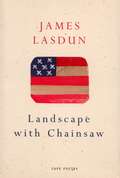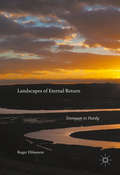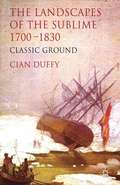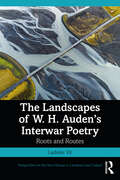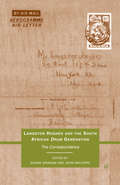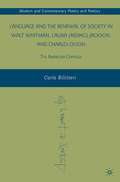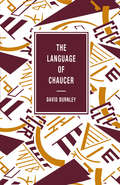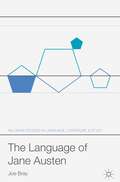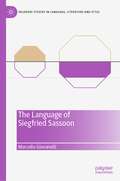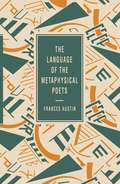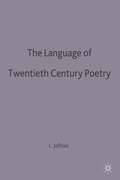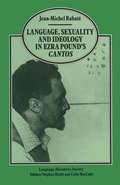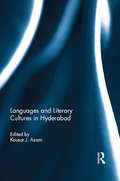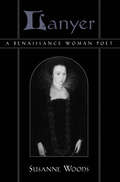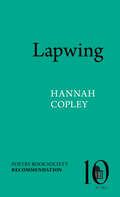- Table View
- List View
Landscape With Chainsaw: Poems (Cape Poetry Ser.)
by James LasdunJames Lasdun's third book of poems explores the themes and tensions of his last two with a new boldness and exuberance, in a series of poems about life in the Catskill mountains outside Woodstock, where the author moved with his family some years ago. Questions of exile and belonging, cutting ties and forming new bonds, figure prominently, as does the struggle to find a viable relationship with the natural world of the mountain wilderness - at once a stunning companion and a ferocious competitor. Out of this - 'the need to carve out a niche for ourselves;/our singular relation to what we love' - rises the book's central image: the chainsaw. Very much a real machine (given to the alarmed poet by his wife), it also comes to form a complex symbol in which all manner of human traits are reflected with an intense, often comical, brilliance.A brilliantly assured, deftly lyrical sequence, Landscape with Chainsaw melds passion with wit, the classical with the quotidian, in a thrilling meditation on history, love, cultural identity and the anxiety of displacement. As an examination of the complexities of deracination and domesticity, it marks the matured genius of one of England's most important poets.
Landscapes of Eternal Return: Tennyson to Hardy
by Roger EbbatsonThis book is about the resonance and implications of the idea of ‘eternal recurrence’, as expounded notably by Nietzsche, in relation to a range of nineteenth-century literature. It opens up the issue of repetition and cyclical time as a key feature of both poetic and prose texts in the Victorian/Edwardian period. The emphasis is upon the resonance of landscape as a vehicle of meaning, and upon the philosophical and aesthetic implications of the doctrine of ‘recurrence’ for the authors whose work is examined here, ranging from Tennyson and Hallam to Swinburne and Hardy. The book offers radically new light on a range of central nineteenth-century texts.
The Landscapes of the Sublime 1700-1830: Classic Ground
by C. DuffyThe Landscapes of the Sublime examines the place of the 'natural sublime' in the cultural history of the eighteenth century and Romantic period. Drawing on a range of scholarship and historical sources, it offers a fresh perspective on the different species of the 'natural sublime' encountered by British and European travellers and explorers.
The Landscapes of W. H. Auden’s Interwar Poetry: Roots and Routes (Perspectives on the Non-Human in Literature and Culture)
by Ladislav VítThis is the first book-length study foregrounding Auden’s sense of place as a means for enhancing our grasp of this crucial twentieth-century poet. Proposing that Auden had a remarkable spatial sensibility, this book concentrates on his treatment of his homeland England, as well as the North Pennines and Iceland, both of which served as his ‘good’ places, ‘holy’ grounds and sources of topophilic sentiment. The readings draw on the scholarship of humanistic geography, tracing patterns of mental constructs which emerge from spatial experience. In a scholarly but engaging way, this book argues that focusing on Auden’s poetics of place as it emerged and evolved can be instrumental to our understanding of this influential poet not only in relation to his epoch but also to the Anglophone poetic tradition. Precisely because of his stature, these elaborations on Auden’s preoccupation with places, escapism, borders and local identity promise to enrich our understanding of the cultural and intellectual climate of the interwar period, when established notions of local places and cultures were beginning to be contested by internationalisation. This study will be of interest to both academics and students in the field of Anglophone literary studies while also appealing to those attracted to Auden’s poetry, interwar culture and the literary representation of space.
The Landscapes of W. H. Auden’s Interwar Poetry: Roots and Routes (Perspectives on the Non-Human in Literature and Culture)
by Ladislav VítThis is the first book-length study foregrounding Auden’s sense of place as a means for enhancing our grasp of this crucial twentieth-century poet. Proposing that Auden had a remarkable spatial sensibility, this book concentrates on his treatment of his homeland England, as well as the North Pennines and Iceland, both of which served as his ‘good’ places, ‘holy’ grounds and sources of topophilic sentiment. The readings draw on the scholarship of humanistic geography, tracing patterns of mental constructs which emerge from spatial experience. In a scholarly but engaging way, this book argues that focusing on Auden’s poetics of place as it emerged and evolved can be instrumental to our understanding of this influential poet not only in relation to his epoch but also to the Anglophone poetic tradition. Precisely because of his stature, these elaborations on Auden’s preoccupation with places, escapism, borders and local identity promise to enrich our understanding of the cultural and intellectual climate of the interwar period, when established notions of local places and cultures were beginning to be contested by internationalisation. This study will be of interest to both academics and students in the field of Anglophone literary studies while also appealing to those attracted to Auden’s poetry, interwar culture and the literary representation of space.
Langston Hughes and the South African Drum Generation: The Correspondence
by Shane Graham and John WaltersThis collection combines previously unpublished letters between African-American poet Langston Hughes and South-African writers of the 1950s and 1960s with scholarly commentary and criticism. The letters tell a fascinating story of the civil rights movement and apartheid and the struggle to overthrow it.
Language and the Renewal of Society in Walt Whitman, Laura: The American Cratylus (Modern and Contemporary Poetry and Poetics)
by C. BillitteriThis book takes up the utopian desire for a perfect language of words that give direct expression to the real, known in Western thought as Cratylism, and its impact on the social visions and poetic projects of three of the most intellectually ambitious of American writers: Walt Whitman, Laura (Riding) Jackson, and Charles Olson.
Language at the Boundaries: Philosophy, Literature, and the Poetics of Culture
by Peter CarravettaIs poetry still relevant today, or is it merely a dwindling historical art? How have poets of the recent past dealt with challenges to poetics?Seeking to chart the poetic act in a period not so much hostile as indifferent to poetry, Language at the Boundaries outlines spaces where poetry and poetics emerge in migration, translation, world literature, canon formation, and the history of science and technology.One can only come so close to fully possessing or explaining everything about the poetic act, and this book grapples with these limits by perusing, analyzing, deconstructing, and reconstructing creativity, implementing different approaches in doing so. Peter Carravetta consolidates historical epistemological positions that have accrued over the last several decades, some spurred by the modernism/postmodernism debate, and unpacks their differences--juxtaposing Vico with Heidegger and applying the approaches of translation studies, decolonization, indigeneity, committed literature, and critical race theory, among others. What emerges is a defense and theory of poetics in the contemporary world, engaging the topic in a dialectic mode and seeking grounds of agreement.
Language at the Boundaries: Philosophy, Literature, and the Poetics of Culture
by Peter CarravettaIs poetry still relevant today, or is it merely a dwindling historical art? How have poets of the recent past dealt with challenges to poetics?Seeking to chart the poetic act in a period not so much hostile as indifferent to poetry, Language at the Boundaries outlines spaces where poetry and poetics emerge in migration, translation, world literature, canon formation, and the history of science and technology.One can only come so close to fully possessing or explaining everything about the poetic act, and this book grapples with these limits by perusing, analyzing, deconstructing, and reconstructing creativity, implementing different approaches in doing so. Peter Carravetta consolidates historical epistemological positions that have accrued over the last several decades, some spurred by the modernism/postmodernism debate, and unpacks their differences--juxtaposing Vico with Heidegger and applying the approaches of translation studies, decolonization, indigeneity, committed literature, and critical race theory, among others. What emerges is a defense and theory of poetics in the contemporary world, engaging the topic in a dialectic mode and seeking grounds of agreement.
The Language of Chaucer (The Language of Literature)
by David BurnleyIn this book David Burnley demonstrates that an understanding of Chaucer's social, cultural, and literary world is vital to our understanding of his language and meaning. The first part of the book, drawing on modern linguistics, concentrates on the text and on approaches to interpreting the poet's grammar and syntax. The second part treats Chaucer's language and vocabulary in its broader contemporary context, dealing with language use, style and variety.
The Language of Contemporary Poetry: A Framework for Poetic Analysis (Palgrave Studies in Language, Literature and Style)
by Lesley JeffriesThis book introduces a new way of looking at how poems mean, drawing on the framework first developed in the author’s book Critical Stylistics, but applied here to aesthetic more than ideological meaning. The aim is to empower readers of poetry to articulate the features of poetic language that they come across and explain to themselves and others why these features convey the meanings that they do. While this volume focuses on contemporary poets writing in English and mostly based in the UK and Ireland, the framework will work just as well for other eras’ poetry, as well as for other cultures and languages.
The Language of Dystopia (Palgrave Studies in Language, Literature and Style)
by Jessica NorledgeThis book presents an extended account of the language of dystopia, exploring the creativity and style of dystopian narratives and mapping the development of the genre from its early origins through to contemporary practice. Drawing upon stylistic, cognitive-poetic and narratological approaches, the work proposes a stylistic profile of dystopia, arguing for a reader-led discussion of genre that takes into account reader subjectivity and personal conceptualisations of prototypicality. In examining and identifying those aspects of language that characterise dystopian narratives and the experience of reading dystopian fictions, the work discusses in particular the manipulation and construction of dystopian languages, the conceptualisation of dystopian worlds, the reading of dystopian minds, the projection of dystopian ethics, the unreliability of dystopian refraction, and the evolution and hybridity of the dystopian genre.
The Language of French Symbolism
by James R. LawlerThe traits that characterize the "language" of French Symbolism are the center of these essays. In interpreting major or previously neglected compositions by Mallarmé, Verlaine, Rimbaud, Claudel, Valéry, and Apollinaire, the author shows how each of these poets worked with the elements that distinguish this influential group of writers as a whole.Originally published in 1969.The Princeton Legacy Library uses the latest print-on-demand technology to again make available previously out-of-print books from the distinguished backlist of Princeton University Press. These editions preserve the original texts of these important books while presenting them in durable paperback and hardcover editions. The goal of the Princeton Legacy Library is to vastly increase access to the rich scholarly heritage found in the thousands of books published by Princeton University Press since its founding in 1905.
The Language of Jane Austen (Language, Style and Literature)
by Joe BrayJoe Bray’s careful analysis of Jane Austen’s stylistic techniques reveals that the genius of her writing is far from effortless; rather he makes the case for her as a meticulous craftswoman and a radical stylistic pioneer. Countering those who have detected in her novels a dominant, authoritative perspective, Bray begins by highlighting the complex, ever-shifting and ambiguous nature of the point of view through which her narratives are presented. This argument is then advanced through an exploration of the subtle representation of speech, thought and writing in Austen’s novels. Subsequent chapters investigate and challenge the common critical associations of Austen’s style with moral prescriptivism, ideas of balance and harmony, and literal as opposed to figurative expression. The book demonstrates that the wit and humour of her fiction is derived instead from a complex and subtle interplay between different styles. This compelling reassessment of Austen’s language will offer a valuable resource for students and scholars of stylistics, English literature and language and linguistics.
The Language of Siegfried Sassoon (Palgrave Studies in Language, Literature and Style)
by Marcello GiovanelliThis book presents a cognitive stylistic analysis of the writing of Siegfried Sassoon, a First World War poet who has typically been perceived as a poet of protest and irony, but whose work is in fact multi-faceted and complex in theme and shifted in style considerably throughout his lifetime. The author starts from the premise that a more systematic account of Sassoon’s style is possible using the methodology of contemporary stylistics, in particular Cognitive Grammar. Using this as a starting point, he revisits common ideas from Sassoon scholarship and reconfigures them through the lens of cognitive stylistics to provide a fresh perspective on Sassoon's style. This book will be of interest to students and scholars of stylistics, war poetry, twentieth-century literature, and cognitive linguistics.
The Language of the Metaphysical Poets
by Frances AustinIn this volume, Dr Frances Austin examines the language of the five best-known metaphysical poets, Donne, Herbert, Crashaw, Vaughan and Traherne. She shows how the characteristics of their vocabulary, figurative language, syntactical structures and versification reflect their individual attitudes to their shared Christian faith, which is the subject matter of most of their poetry. The diversity of language, albeit having a common basis, is demonstrated in the course of this study.
The Language of Twentieth Century Poetry
by Lesley HeffriesThis book draws on examples from throughout the twentieth century to illustrate the diversity of techniques used in this century's poetry. Organised according to linguistic themes, rather than chronologically, the chapters introduce the reader to the more subtle uses of sound, structure and meaning as well as illustrating well-known techniques handed-down from the poetic tradition. Examples are taken from the famous writers of the twentieth century, such as Yeats, Eliot and Plath and from less well-known poets. The book culminates in a chapter which draws together the linguistic themes into an integrated analysis of two rather different poems.
The Language of Wordsworth and Coleridge (The Language of Literature)
by Frances AustinIn this volume, Dr Frances Austin examines the language of William Wordsworth and Samuel Taylor Coleridge, both regarded as initiators of the Romantic movement in English Literature. She compares and contrasts the poetic language of the two poets, showing their interest in language and their deliberate break from the poetic diction of their predecessors, and the way in which that interest is transmuted into poetry.
Language, Sexuality and Ideology in Ezra Pound’s Cantos (Language, Discourse, Society)
by Jean-Michel RabateLanguages and Literary Cultures in Hyderabad
by Kousar J. AzamThere is great interest in recent scholarship in the study of metropolitan cultures in India as evident from the number of books that have appeared on cities such as Delhi, Mumbai, Chennai and Kolkata. Though Hyderabad has a rich archive of history scattered in many languages, very few attempts have been made to bring this scholarship together. The papers in this volume bring together this scholarship at one place. They trace the contribution of different languages and literary cultures to the multicultural mosaic that is the city of Hyderabad How it has acquired this uniqueness and how it has been sustained is the subject matter of literary cultures in Hyderabad. This work attempts to trace some aspects of the history of major languages practiced in the city. It also reviews the contribution of the various linguistic groups that have added to the development not just of varied literary cultures, but also to the evolution of an inclusive Hyderabadi culture. The present volume, it is hoped, will enthuse both younger and senior scholars and students to take a fresh look at the study of languages and literary cultures as they have evolved in India's cities and add to the growing scholarship of metropolitan cultures in India.
Languages and Literary Cultures in Hyderabad
by Kousar J. AzamThere is great interest in recent scholarship in the study of metropolitan cultures in India as evident from the number of books that have appeared on cities such as Delhi, Mumbai, Chennai and Kolkata. Though Hyderabad has a rich archive of history scattered in many languages, very few attempts have been made to bring this scholarship together. The papers in this volume bring together this scholarship at one place. They trace the contribution of different languages and literary cultures to the multicultural mosaic that is the city of Hyderabad How it has acquired this uniqueness and how it has been sustained is the subject matter of literary cultures in Hyderabad. This work attempts to trace some aspects of the history of major languages practiced in the city. It also reviews the contribution of the various linguistic groups that have added to the development not just of varied literary cultures, but also to the evolution of an inclusive Hyderabadi culture. The present volume, it is hoped, will enthuse both younger and senior scholars and students to take a fresh look at the study of languages and literary cultures as they have evolved in India's cities and add to the growing scholarship of metropolitan cultures in India.
The Lapidary's Nosegay (Mountain West Poetry Series)
by Lara CandlandThe Lapidary’s Nosegay, Lara Candland’s primer of poems, presents to readers a bouquet of resplendent poems that Candland has created, collaged, curated, and reimagined by using the rich floral and gem imagery in the poetry of Emily Dickinson as her primary source material. Dickinson and Candland share linguistic and theological roots in the Bible, nineteenth-century American Protestantism, and a lexicon distinctive to their specific individuarian communities, and this collection of poems draws a serpentine kind of map across nearly two centuries, journeying from Amherst, Massachusetts, to Provo, Utah, from Dickinson’s severe and lush New England to Candland’s own jagged, harsh, and stunning high desert Utah. The Lapidary’s Nosegay explores the ways that both poets have simultaneously challenged and embraced the axiomatic constraints of religion, landscape, and cultural conventions and expectations of each poet’s time and place. Aesthetically, Candland attempts to challenge the hierarchies of the page through linguistic, typographic, and sonic experimentation. The Lapidary’s Nosegay carries Dickinsonian echoes to alliterative and parenthetic excessivities that indicate sound stresses or that pictographically invoke sun, god, ghosts, ecstasy, and the jewels and flowers tumbling throughout Dickinson’s own poems. This collection works at toppling textual hierarchies, systematically jumbling sound, text, meaning, symbol, and context and entering the vein of radical American aesthetics, politics, and culture that have shaped Candland’s life and poetics.
Lapwing (Pavilion Poetry)
by Hannah CopleyPoetry Book Society Recommendation Summer 2024 Migrating across voices and blurring the divide between bird and human, self and other, Hannah Copley’s Lapwing explores restlessness, love, and ecological and personal grief in a vivid and incantatory sequence of poems. A lyrical biography of a bird and a fragmented study of a flawed and mutable creature bearing its name, Copley’s second collection takes inspiration from John Gower’s brid falseste of alle and its many literary guises. At the heart of the book are the shifting figures of Lapwing and Peet, two creatures whose overlapping narratives echo the double note of the bird’s cry. In Lapwing, known by countless names, migratory, and slowly disappearing beneath addiction, Copley examines a life in a slow tumble, as we are transported into a world shaped by real and imagined predators. Running alongside Lapwing is the searching voice of Peet, a daughter left to understand her father’s vanishing while trying to make a life in a habitat no longer fit for survival. Bold, exacting, and deeply personal, Copley’s poems call out from empty nests, drained wetlands, and ploughed fields to create a soundscape of endangerment and wonder. *Lapwing *asks that we consider how, like the bird itself, we must all dissemble to survive.
Lapwing (Pavilion Poetry)
by Hannah CopleyPoetry Book Society Recommendation Summer 2024 Migrating across voices and blurring the divide between bird and human, self and other, Hannah Copley’s Lapwing explores restlessness, love, and ecological and personal grief in a vivid and incantatory sequence of poems. A lyrical biography of a bird and a fragmented study of a flawed and mutable creature bearing its name, Copley’s second collection takes inspiration from John Gower’s brid falseste of alle and its many literary guises. At the heart of the book are the shifting figures of Lapwing and Peet, two creatures whose overlapping narratives echo the double note of the bird’s cry. In Lapwing, known by countless names, migratory, and slowly disappearing beneath addiction, Copley examines a life in a slow tumble, as we are transported into a world shaped by real and imagined predators. Running alongside Lapwing is the searching voice of Peet, a daughter left to understand her father’s vanishing while trying to make a life in a habitat no longer fit for survival. Bold, exacting, and deeply personal, Copley’s poems call out from empty nests, drained wetlands, and ploughed fields to create a soundscape of endangerment and wonder. *Lapwing *asks that we consider how, like the bird itself, we must all dissemble to survive.
